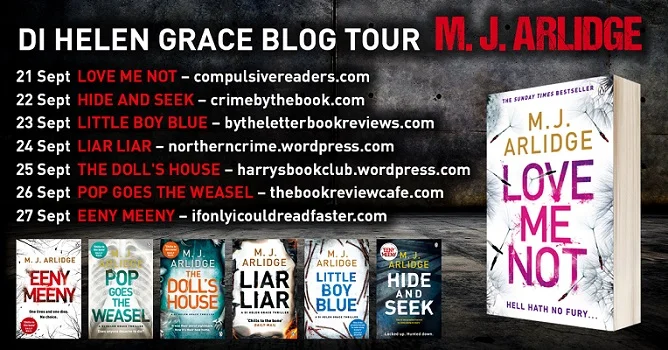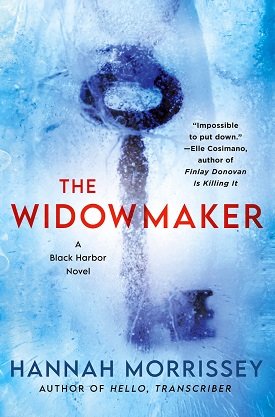CBTB Author Interview: M.J. Arlidge
Every reader has that dream list of favorite authors they would love to meet; for me, one of the people at the top of my list is M.J. Arlidge, author of the DI Helen Grace Series. While in Scotland for the Bloody Scotland crime festival, I had the fantastic chance to sit down with Arlidge and interview him about the Helen Grace series as a whole, and HIDE AND SEEK in particular! HIDE AND SEEK releases in the US on October 10th, 2017, and it’s one of my top favorite series installments. If you missed it, you can read my full review of HIDE AND SEEK here!
I’m doubly excited because this interview is part of the “Graceland Tour,” a brilliant blog tour concept in which Arlidge talks about the world of Helen Grace book by book. You can find the full schedule for this blog tour below—make sure to check out the upcoming blog posts to get a behind-the-scenes glimpse into all the Helen Grace books!
Welcome to Graceland!
MJ Arlidge talks about the world of DI Helen Grace: 7 books in 7 days.
Without further ado—let’s dive into the interview! Many thanks to Matt Arlidge for taking the time to answer my questions and hang out with me at Bloody Scotland, and to his fantastic publicist Angela for coordinating this interview.
INTERVIEW PART 1: THE DI HELEN GRACE SERIES
Where did Arlidge first come up with the idea for the Helen Grace books?
Arlidge was working as a TV producer at the time that he had the idea for EENY MEENY. This idea came from all the reality shows where we judge people: shows like Big Brother, Survivor, and more, where contestants are judged by their peers and “voted off” the show. Arlidge began to think, wouldn’t it be interesting if a serial killer did that - judge who should live and who should die? Arlidge actually first pitched it as a TV show, but it was a bit too dark, so he then wrote it as a novel.
The inspiration for Helen came in part from Stieg Larsson’s character of Lisbeth Salander. Arlidge was drawn to her complexity and darkness. He was determined that the main character of his book should be a woman as well: he felt women tend to be a bit more complex emotionally, and that life is still harder for women in many ways. This also felt, to Arlidge, like a moment where female crime fighters should step forward—but he wanted to avoid cliches of the genre at the same time. With that in mind, Arlidge created Helen Grace: a tough, almost invincible-seeming police officer who, at the same time, is very isolated and vulnerable. She’s not your ordinary “damaged police officer” who is an alcoholic—Arlidge intentionally avoided that stereotype, and made Helen very strict about not drinking. But of course, Helen needs a release just like anyone else… and for Helen, this release comes in the form of BDSM. Her closest relationship is actually with a man she pays to beat her, and she uses this pain to control her emotions. This adds yet another facet to Helen's character - her inability to sustain close personal relationships.
Arlidge was at first worried that Helen would be too cold for people! But more often than not, he meets readers who just want her to be happy - people actually seem to genuinely worry for her, and want her to have a happy ending.
When he first came up with Helen's character and wrote EENY MEENY, did Arlidge anticipate it becoming a whole series?
Yes. Arlidge actually pitched the first 7 books in the series to begin with! He had all different ideas for what Helen could do, and saw tons of possibilities for the series.
We all love Helen Grace - she’s a fantastic character to root for. But what about the villains of this series? The Helen Grace books always have such compelling antagonists, I was curious how Arlidge goes about creating these characters.
People are interested in crime fiction because we’re curious why people do things that are bad or immoral. Serial killers are of course the extreme end of the spectrum, and Arlidge is fascinated by delving into the psychology of why people would do something so transgressive. Similarly, what situations would push people into that almost primal fear where they would act violently? Arlidge explores these ideas and more in his series' villains.
The idea for THE DOLL’S HOUSE actually came about because Arlidge was on vacation with his family. During this vacation, his kids would want to have a sleepover in the same room. But of course, every night after they had fallen asleep, he would go into the room and bring his daughter back to her own room for the rest of the night. From that experience, Arlidge began to wonder: what would happen if a grown woman woke up in a bed that wasn’t her own? And what would the psychology be of a person who would do that - kidnap women in the night like that? These ideas can come from anywhere, and Arlidge is curious to explore the mentality of the perpetrators of these crimes.
INTERVIEW PART 2: HIDE AND SEEK (Helen Grace #6)
HIDE AND SEEK delves into a totally new world for Helen: it finds Helen incarcerated, framed for multiple homicides. What kind of research went into writing a book set primarily in a prison? Does Arlidge tend to put the same kind of research into each series installment?
In Arlidge’s point of view, ultimately police procedure is a bit tedious, so there isn’t necessarily a ton of research put into these books overall. Arlidge views himself as writing thrillers, which are quite different from procedural-heavy books; for him, it’s all about the velocity of the narrative, rather than those procedural details.
However, HIDE AND SEEK was a bit of an unusual experience for him! The first version of HIDE AND SEEK was actually quite gothic, bloody, and very dramatic! But then he began to research what female prisons are actually like, and he discovered that they were nothing like he had imagined. They are very different from male prisons; by in large, female inmates have been incarcerated for crimes that are not violent, and they don’t as frequently pose physical threats to one another. What Arlidge really found compelling was considering how in the case of imprisoning a woman, the real threat is the threat this poses to their families. Women are still most frequently the caregivers for children, and suddenly the story in his head became more about the social cost of imprisoning women, rather than something very gothic and bloody. He felt it became a much more interesting story this way!
As he described it to me, this was actually a really striking and unusual example for him of research completely changing the course of his writing.
HIDE AND SEEK is totally different from the previous Helen Grace books in its setting. The majority of this book is set in prison. Why did Arlidge choose to focus so much on this setting?
Arlidge wanted the previous series installment LITTLE BOY BLUE and HIDE AND SEEK to be almost one story told over two books. Both stories are claustrophobic in their own way. If you’ve read LITTLE BOY BLUE, you’ll know that the killings in that story have a very claustrophobic element to them, and in HIDE AND SEEK, the claustrophobia comes into play with its locked-in setting.
With each book, Arlidge wants to put his characters in the toughest possible settings, and he also wants to add a new element into each series installment. In HIDE AND SEEK he thought, wouldn’t it be interesting to have Helen locked up with all the people she has put away? He described the balancing act of writing a series: in each book, you’re trying to keep the things that people love, but you also want to reinvent the novel a little bit so it feels fresh. For example, while HIDE AND SEEK is this claustrophobic, locked-in story, the next book in the series, LOVE ME NOT, is more of a free-wheeling story with Helen tearing all over town - one which I cannot wait to read!
When readers look at the Helen Grace series as a whole, you can see how Arlidge has achieved this balance with each book—they each contrast their predecessor just a little bit, while still delivering the pacing and thrills readers have become accustomed to.
In HIDE AND SEEK, Helen's friend and colleague Charlie Brooks gets her own moment in the spotlight. With Helen in prison, Charlie gets to spread her wings a bit and take on the role Helen usually plays - that of the vigilante, renegade cop.
Charlie plays a couple different roles in the series. She is definitely the light to Helen's dark throughout the books - readers will know Charlie as the loyal, often a bit more level-headed friend who supports Helen through thick and thin. But Charlie is also an opportunity for Arlidge to write about the experience of being a parent. Those small details of Charlie’s life - the moments where she’s caring for her child, juggling work and commitments to her family - hopefully are relatable for parents reading the books.
The relationship between Helen and Charlie is also so important to Arlidge because a lot of times, the narrative about women is quite catty; women are often represented as competing against one another and tearing one another down. Arlidge wants to provide a different example of female friendship through Helen and Charlie; their friendship is extremely strong, and each woman provides the other with support through the many challenges they face.
HIDE AND SEEK has arguably my favorite conclusion of any of Arlidge’s books! I absolutely loved this plot twist, and was curious: did Arlidge know this story’s twist from the beginning?
Arlidge always knows all the twists of each story when he starts writing! This particular twist really excited him to write (and, side note, it was completely fantastic to read). Arlidge was particularly excited to write this specific character who turns out to be the story’s villain. He specifically set out to create more red herrings in this story, too—he wanted to have fun disguising and cloaking this killer’s identity! (And it worked on me, I can tell you that!)
If you’ve already read HIDE AND SEEK, you’ll know just how exceptional the final reveal of the killer’s identity really was. Without spoiling anything, Arlidge has achieved what he intended to do in subverting a stereotype of the genre with this killer’s identity. I won’t write any more on this for fear of spoiling anything for readers who have yet to read HIDE AND SEEK - but I will say, I did not see this reveal coming, and I was completely, totally shocked and satisfied by the story’s ultimate reveal. You'll just have to read HIDE AND SEEK for yourself to experience this brilliant twist!
CBTB Reviews the DI Helen Grace Series
Curious what I thought of each book in the DI Helen Grace Series? You can find my full review of each book linked below! A star next to the title indicates it's one of my favorites in the series.
Book 1: EENY MEENY
"A strong female lead, a story unburdened by unnecessary details, a satisfyingly twisted villain, short chapters that keep you turning the pages as quickly as you can… these are just a few of the things I loved about this book." READ THE REVIEW
Book 2: POP GOES THE WEASEL
"There's just nothing like a really gripping cat-and-mouse mystery, and M.J. Arlidge writes these with the best of them." READ THE REVIEW
Book 3: THE DOLL'S HOUSE ★
"This story has all the elements readers have come to know and love from M. J. Arlidge: short, taut chapters, a strong female lead and her struggle against personal demons, and a wickedly clever and twisted killer." READ THE REVIEW
Book 4: LIAR LIAR
"[Arlidge's] books are consistently fast-paced, engaging, and not too graphic while remaining suspenseful." READ THE REVIEW
Book 5: LITTLE BOY BLUE ★
"LITTLE BOY BLUE … further proves why this book and this series deserve to be on your reading list. … Arlidge's most provocative book yet." READ THE REVIEW
Book 6: HIDE AND SEEK ★
"[T]his superb thriller reads like a cross between a locked room mystery and an episode of Criminal Minds, serving up one of my favorite reads of the series so far." READ THE REVIEW
Many thanks to M.J. Arlidge for taking the time to answer my questions, and for Angela McMahon for facilitating this interview! You can find my reviews for all the DI Helen Grace books linked below.























Home ownership feel like a distant dream? Zillow listings have you convinced you’ll be renting for the rest of your life? The woman at the heart of Carissa Orlando’s debut The September House feels your pain—and she’s prepared to put up with a lot if it means she and her husband can finally have a place to call their own. In this case, that might just mean living in a house that’s haunted. Playful and irreverent, spine-tingling and spooky, The September House puts a fresh spin on the classic haunted house story, delivering an immersive tale about the secrets lurking within one building’s walls, and within the lives of its inhabitants.